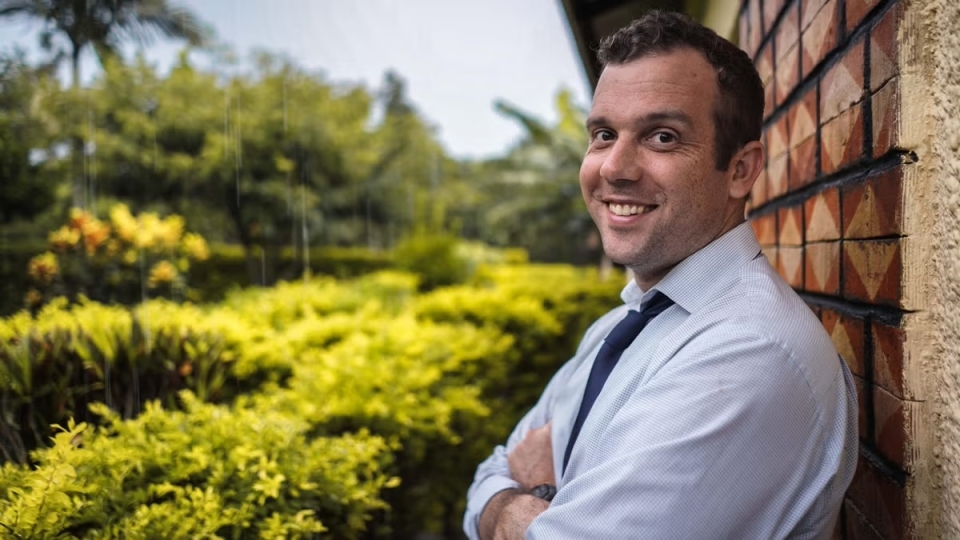Simple Intervention for a Deadly Disease: Alum Leads on Malaria Breakthrough
November 5, 2025
- Author
- Mark Johnson

Malaria expert Dr. Ross Boyce ’01 has developed a breakthrough in preventing the mosquito-borne disease among infants in Uganda. The lifesaving progress comes after a dozen years of work in East Africa and through a simple intervention.
Boyce’s win against malaria earned recognition in recent weeks from one of the world’s premier medical journals.
“We never imagined our work reaching this level of prominence,” Boyce wrote in an email response to questions. “It is a reflection of our longstanding commitment to working closely with the community, while also highlighting the dedication of our Ugandan academic partners and field staff.”
Boyce, a physician and epidemiologist, continually visits villages in western Uganda for his research and work. The new mothers in those villages carry their babies on their backs by wrapping a cotton cloth, called a lesu, around themselves and the infant. Boyce led a study with a Ugandan colleague of the effect of coating the cloth in permethrin, an insect repellent. The idea grew from Boyce’s time as an infantry officer in Iraq, when the Army’s uniforms were coated with the same repellent.
Boyce and his colleagues gave 200 women cloth treated with permethrin. Another 200 women were given wraps without it, serving as a control, or comparison, group.
After 10 months, 16 percent of the babies who were in repellent-treated wraps had gotten sick with malaria, while 34 percent of the control group babies had gotten sick, multiple times in many cases.
That’s a 66 percent reduction in malaria infections, results that were published in September in the New England Journal of Medicine and highlighted by national media, including the New York Times and NPR.
The gains did not require new technology or medicine, and the method of intervention meshed with an existing cultural practice, a point highlighted by the Times story in an observation by Dr. Marta Maia, a medical entomologist and associate professor at the KEMRI Wellcome Trust in Kenya, who was not involved in the research.
“I love this,” Maia said. “The result is better than the vaccine, for a fraction of the cost, and you don’t have issues of cold chain and manufacturing, and it’s so much easier to implement. And you don’t have to convince people they need it. It takes into account the local practices, that people are already wearing their babies and laying them to sleep in the same cloth.”
Boyce’s path to Uganda eschewed the traditional route in medicine. He sandwiched medical school between deployments to Iraq and graduate school in public health in London. He wanted to be more on the front lines than the usual medical research cycle of starting with a mentor and small studies and using successes to secure increasing amounts of funding for more studies.
A residency at Massachusetts General Hospital and their partnership around HIV research in Uganda exposed him to hundreds of children sick with malaria. That became the problem he wanted to solve, and it combined the skills he acquired in class at Davidson, in research at UNC Medical School and, in the Army, fixing roads, installing irrigation systems and vaccinating farm animals.
He built his operation in Uganda over time, from a $25,000 grant for solar power and a refrigerator at a clinic, to a recent, $4.4 million grant from the National Institutes of Health to study malaria control after flooding.
Malaria remains a global killer. Nearly 600,000 people died from it in 2023, nearly all in Africa and most occurred in children younger than 5 years of age, according to the World Health Organization. Vaccines are starting to become available in Africa, but they require multiple injections that are not complete prior to 18 months of age, the period when the disease is most deadly.
The study found only a small percentage higher rate of mild skin irritation among the babies with permethrin treated wraps than those in the control group – 17 vs 12.
The baby wrap project leaders still have problems to solve. For example, the insect repellent’s efficacy fades as the wrap is repeatedly washed. In the study, the mothers brought in the wraps every four weeks for retreatment, but that is difficult to replicate on a larger scale.
“The good news is the textile chemistries and manufacturing processes are well established,” Boyce wrote. “It’s just a matter of finding the right combination of treatment and distribution strategies. I’m optimistic we — and we’re engaging a lot of new partners now that the [NEJM] article is out — will get there.”
He also wants to look at putting permethrin on elementary school uniforms.
“Most children in Uganda wear a uniform to school and most only have one or two sets,” Boyce wrote. “That seems like a natural next step, especially as children often walk school in the early morning when the mosquitoes might still be out and about.”
Explore Chemistry at Davidson College
Our department focuses on providing students with individual attention, promoted through small lecture and lab classes taught by professors committed to one-on-one and small-group interactions.



